#19th century techniques
Explore tagged Tumblr posts
Text

Thomas Jennings was a free man born in 1791 in New York City. He was 30 years old when he was granted a patent for a dry cleaning process. In his early 20s Thomas Jennings became a tailor, and later opened a dry cleaning business in the city. As a tailor. Jennings' skills were so admired that people near and far came to him to alter or custom tailor items of clothing for them. Eventually, Jennings reputation grew such that he was able to open his own store on Church street which grew into one of the largest clothing stores in New York City. While running his business Jennings developed dry-scouring. He had many customers complain of their clothes being ruined by stains and so he began experimenting with cleaners and mixtures that would remove the stains without harming the material. He earned a large amount of money as a tailor and even more with his dry scouring invention and most of the money he earned went to his abolitionist activities. In 1831, Thomas Jennings became assistant secretary for the First Annual Convention of the People of Color in Philadelphia, PA. Thomas L. Jennings Dry Scouring technique created modern day dry cleaning. Jennings was fortunate that he was a free man at the time of his invention. Besides all the other indignities and cruelties slaves had to face, they were also ineligible to hold a patent. Under the US patent laws of 1793 a person must sign an oath or declaration stating that they were a citizen of the USA. While there were, apparently, provisions through which a slave could enjoy patent protection, the ability of a slave to seek out, receive and defend a patent was unlikely. Later, in 1858, the patent office changed the laws, stating that since slaves were not citizens, they could not hold a patent. Furthermore, the court said that the slave owner, not being the true inventor could not apply for a patent either. Thomas Jennings died in New York City in 1856.
#black history#Thomas Jennings#dry cleaning#inventor#tailor#abolitionist#New York City#patent law#slavery#abolitionist activities#dry scouring technique#historical injustice#patent discrimination#civil rights activism#African American entrepreneurship#19th century America
469 notes
·
View notes
Text


Köbbler Sisters in ‘pas de deux de Shawl’ —Watercolor illustration by Johannes Jelgerhuis, 1812, Napoleonic era
According to Manon Schooneman, this illustration (drawn in 1812) is the earliest documented evidence of pointe ballet, which is the style of ballet where dancers stand on their toes.
This drawing was a surprising discovery because it was widely believed that the pointe technique was first performed in 1825 by the Swedish-Italian ballerina Marie Taglioni.
Background on the drawing:
Depicts an Austrian-German family of dancers, the sisters Köbbler, who moved to the Netherlands (which was then part of the French state under the Napoleonic Empire) in the 1810s.
(Source: Allard Pierson Vertelt: Tekening van de eerste spitz)
#ballet#pointe#pointe technique#Johannes Jelgerhuis#Jelgerhuis#napoleonic era#napoleonic#first french empire#french empire#19th century#ballerinas#history#dutch history#Köbbler Sisters
23 notes
·
View notes
Text

The Groenmarkt at The Hague by Petrus van Schendel.
#Petrus van Schendel#arte#history#art#painting#artwork#oil painting#paintings#art history#19th century art#realism#pintura#dibujo#kunst#hague#light#art techniques
8 notes
·
View notes
Text
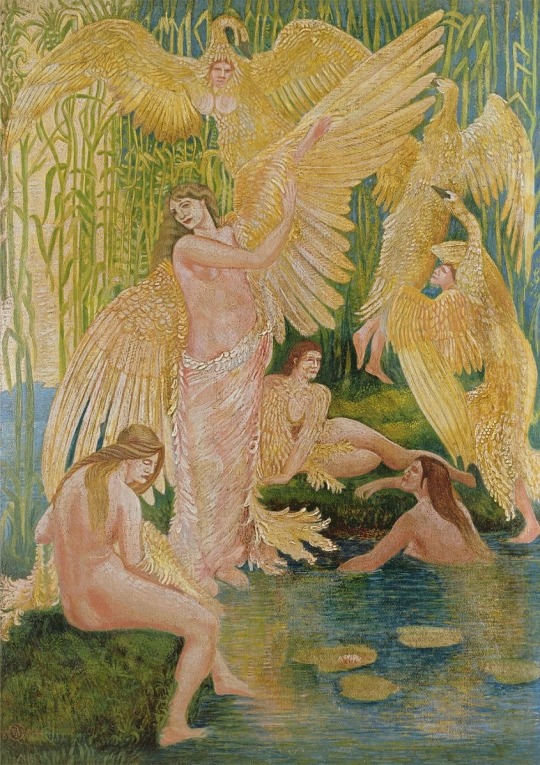
The Swan Maidens, C. 1894
Walter Crane
#oil painting#mixed technique#late 19th century#19th century#historical#historical painting#ethereal#ethereal vibes#ethereal art#ethereal painting#swans#dreamy
10 notes
·
View notes
Text
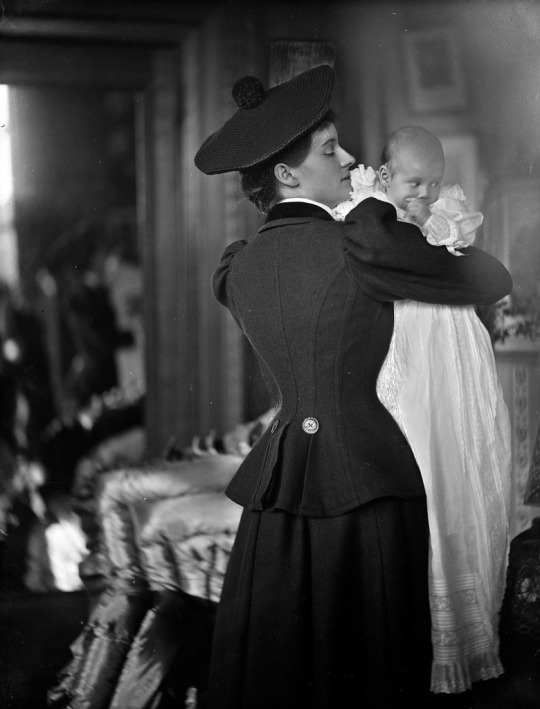
The Marchioness of Waterford and her first child Lady Blanche Maud de la Poer Beresford. Circa 1898. Ireland.
#photography#fashion#they snatched her waist#they had photoshop techniques then#19th century#20th century#Victorian#victorian women#Edwardian#aristocracy#oceancentury#upload
18 notes
·
View notes
Text
academic art
Academic art, a style prevalent in the 19th century, adhered to traditional techniques and subject matter, often depicting historical, mythological, or biblical themes. It emphasized realism, precise draftsmanship, and idealized forms, aiming to elevate the viewer's moral and intellectual sensibilities. Led by institutions like the École des Beaux-Arts in Paris, academic art set strict standards, which some saw as stifling creativity. Yet, its influence persisted, shaping the development of art education and laying the groundwork for later movements to rebel against its conventions.

flaming june by frederic leighton
#art#artist#european style#academic art#daily art#french#frech aesthetic#french style#historical#greek mythology#traditional techniques#realism#école des beaux-arts#paris#art education#19th century#romantacism#neoclassicism#dark academism#light academism#academism#l'art pompier#eclecticism#historicism#syncretism#painting#sculpture#european academic#french académie#moral and intellectual sensibilities
5 notes
·
View notes
Text


#Star Trek Enterprise#Enterprise#The Council#Phlox#Dr. Phlox#Phlox's Tapeworm straight out of the 19th century weight loss techniques#God Phlox would love the DW Adipose#secret enterprise rewatch
12 notes
·
View notes
Text
on neuschwanstein castle (part 1)
This is an essay in two parts.

Neuschwanstein Concept Drawing by the stage designer (!!) Christian Jank (1869).
There exist in architecture clear precedents to the McMansion that have nothing to do with suburban real estate. This is because “McMansionry” (let’s say) has many transferable properties. Among them can be included: 1) a diabolical amount of wealth that must be communicated architecturally in the most frivolous way possible, 2) a penchant for historical LARPing primarily informed by media (e.g. the American “Tuscan kitchen”) and 3) the execution of historical styles using contemporary building materials resulting in an aesthetic affect that can be described as uncanny or cheap-looking. By these metrics, we can absolutely call Neuschwanstein Castle, built by the architect Eduard Riedel for King Ludwig II of Bavaria, a McMansion.
Constructed from 1869 through 1886 – the year of Ludwig’s alleged suicide after having been ousted and declared insane – the castle cost the coffers of the Bavarian state and Ludwig himself no fewer than 6.2 million German gold marks. (That's an estimated 47 million euros today.) The castle's story is rife with well-known scandal. I'm sure any passing Swan Enthusiast is already familiar with Ludwig’s financial capriciousness, his called-off marriage and repressed homosexuality, his parasocial obsession with Richard Wagner, his complete and total inability to run his country, and his alleged "madness," as they used to call it. All of these combine to make Neuschwanstein inescapable from the man who commissioned it -- and the artist who inspired it. Say what you like about Ludwig and his building projects, but he is definitely remembered because of them, which is what most monarchs want. Be careful what you wish for.

Neuschwanstein gatehouse.
How should one describe Neuschwanstein architecturally? You’d need an additional blog. Its interiors alone (the subject of the next essay) range from Neo-Baroque to Neo-Byzantine to Neo-Gothic. There are many terms that can loosely define the palace's overall style: eclecticism, medieval revivalism, historicism, chateauesque, sclerotic monarchycore, etc. However, the the most specific would be what was called "castle Romanticism" (Burgenromantik). The Germans are nothing if not literal. Whatever word you want to use, Neuschwanstein is such a Sistine Chapel of pure sentimentality and sugary kitsch that theme park architecture – most famously, Disney's Cinderella’s castle itself – owes many of its medieval iterations to the palace's towering silhouette.
There is some truth to the term Burgenromantik. Neuschwanstein's exterior is a completely fabricated 19th century storybook fantasy of the Middle Ages whose precedents lie more truthfully in art for the stage. As a castle without fortification and a palace with no space for governance, Neuschwanstein's own program is indecisive about what it should be, which makes it a pretty good reflection of Ludwig II himself. To me, however, it is the last gasp of a monarchy whose power will be totally extinguished by that same industrial modernity responsible for the materials and techniques of Neuschwanstein's own, ironic construction.
In order to understand Neuschwanstein, however, we must go into two subjects that are equally a great time for me: 19th century medievalism - the subject of this essay - and the opera Lohengrin by Richard Wagner, the subject of the next. (1)
Part I: Medievalisms Progressive and Reactionary

The Middle Ages were inescapable in 19th century Europe. Design, music, visual art, theater, literature, and yes, architecture were all besotted with the stuff of knights and castles, old sagas, and courtly literature. From arch-conservative nationalism to pro-labor socialism, medievalism's popularity spanned the entire political spectrum. This is because it owes its existence to a number of developments that affected the whole of society.
In Ludwig’s time, the world was changing in profound, almost inconceivable ways. The first and second industrial revolutions with their socioeconomic upheavals and new technologies of transport, manufacturing, and mass communication, all completely unmade and remade how people lived and worked. This was as true of the average person as it was of the princes and nobles who were beginning to be undermined by something called “the petit bourgeoisie.”
Sustenance farming dwindled and wage labor eclipsed all other forms of working. Millions of people no longer able to make a living on piecemeal and agricultural work flocked to the cities and into the great Molochs of factories, mills, stockyards, and mines. Families and other kinship bonds were eroded or severed by the acceleration of capitalist production, large wars, and new means of transportation, especially the railroad. People became not only alienated from each other and from their labor in the classical Marxist sense but also from the results of that labor, too. No longer were chairs made by craftsmen or clothes by the single tailor -- unless you could afford the bespoke. Everything from shirtwaists to wrought iron lamps was increasingly mass produced - under wretched conditions, too. Things – including buildings – that were once built to last a lifetime became cheap, disposable, and subject to the whimsy of fashion, sold via this new thing called “the catalog.”

William Morris' painting Le Belle Iseult (1868).
Unsurprisingly, this new way of living and working caused not a little discontent. This was the climate in which Karl Marx wrote Capital and Charles Dickens wrote A Christmas Carol. More specific to our interests, however, is a different dissenter and one of the most interesting practitioners of medievalism, the English polymath William Morris.
A lover of Arthurian legend and an admirer of the architect and design reformer John Ruskin, Morris was first trained in the office of architect G. E. Street, himself a die-hard Gothic Revivalist. From the very beginning, the Middle Ages can be found everywhere in Morris' work, from the rough-hewn qualities of the furniture he helped design to the floral elements and compositions of the art nouveau textiles and graphics he's most famous for -- which, it should be said, are reminiscent of 15th century English tapestries. In addition to his design endeavors, Morris was also a gifted writer and poet. His was a profound love for medieval literature, especially Norse sagas from Iceland. Some of these he even translated including the Volsunga Saga -- also a preoccupation of Wagner's. Few among us earn the title of polymath, but Morris' claim to it is undeniable. Aside from music, there really wasn't any area of creative life he didn't touch.
However, Morris' predilection for the medieval was not just a personal and aesthetic fascination. It was also an expression of his political rejection of the capitalist mode of production. As one of the founders of the English Arts & Crafts Movement, Morris called for a rejection of piecemeal machine labor, a return to handicraft, and overall to things made well and made with dignity. While this was and remains a largely middle class argument, one that usually leads down the road of ethical consumption, Morris was right that capitalism's failing of design and architecture did not just lie with the depreciated quality of goods, but the depreciated quality of life. His was the utopian call to respect both the object and the laborer who produced it. To quote from his 1888 essay called "The Revival of Architecture," Morris dreamed of a society that "will produce to live and not live to produce, as we do." Indeed, in our current era of AI Slop, there remains much to like about the Factory Slop-era call to take back time from the foreman's clock and once more make labor an act of enjoyable and unalienated creativity. Only now it's about things like writing an essay.
I bother to describe Morris at length here for a number of reasons. The first is to reiterate that medievalism's popularity was largely a response to socioeconomic changes. Additionally, since traditionalism - in Ludwig's time and in ours - still gets weaponized by right-wing losers, it's worth pointing out that not all practitioners of medievalism were politically reactionary in nature. However – and I will return to this later – medievalism, reactionary or not, remains inescapably nostalgic. Morris is no exception. While a total rejection of mass produced goods may seem quixotic to us now, when Morris was working, the era before mass industrialization remained at the fringes of living memory. Hence the nostalgia is perhaps to be expected. Unfortunately for him and for us, the only way out of capitalism is through it.
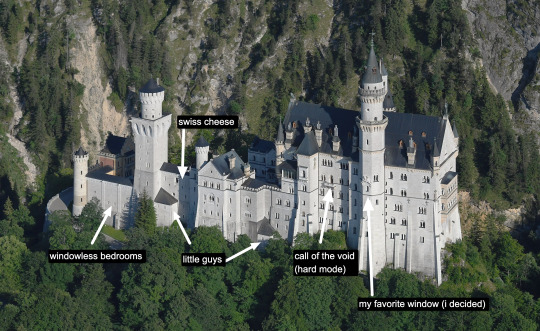
To return again to the big picture: whether one liked it or not, the old feudal world was done. Only its necrotic leftovers, namely a hereditary nobility whose power would run out of road in WWI, remained. For Ludwig purposes, it was a fraught political time in Bavaria as well. Bavaria, weird duck that it was, remained relatively autonomous within the new German Reich. Despite the title of king, Ludwig, much to his chagrin - hence the pathetic Middle Ages fantasizing - did not rule absolutely. His was a constitutional monarchy, and an embattled one at that. During the building of Neuschwanstein, the king found himself wedged between the Franco-Prussian War and the political coup masterminded by Otto von Bismarck that would put Europe on the fast track to a global conflict many saw as the atavistic culmination of all that already violent modernity. No wonder he wanted to hide with his Schwans up in the hills of Schwangau.
The very notion of a unified German Reich (or an independent Kingdom of Bavaria) was itself indicative of another development. Regardless if one was liberal or conservative, a king, an artist or a shoe peddler, the 19th century was plagued by the rise of modern nationalism. Bolstered by new ideas in "medical" “science,” this was also a racialized nationalism. A lot of emotional, political, and artistic investment was put into the idea that there existed a fundamentally German volk, a German soil, a German soul. This, however, was a universalizing statement in need of a citation, with lots of political power on the line. Hence, in order to add historical credence to these new conceptions of one’s heritage, people turned to the old sources.
Within the hallowed halls of Europe's universities, newly minted historians and philologists scoured medieval texts for traces of a people united by a common geography and ethnicity as well as the foundations for a historically continuous state. We now know that this is a problematic and incorrect way of looking at the medieval world, a world that was so very different from our own. A great deal of subsequent medieval scholarship still devotes itself to correcting for these errors. But back then, such scholarly ethics were not to be found and people did what they liked with the sources. A lot of assumptions were made in order to make whatever point one wanted, often about one's superiority over another. Hell, anyone who's been on Trad Guy Deus Vult Twitter knows that a lot of assumptions are still made, and for the same purposes.(2)
Meanwhile, outside of the academy, mass print media meant more people were exposed to medieval content than ever before. Translations of chivalric romances such as Wolfgang von Eschenbach’s Parzival and sagas like the Poetic Edda inspired a century’s worth of artists to incorporate these characters and themes into their work. This work was often but of course not always nationalistic in character. Such adaptations for political purposes could get very granular in nature. We all like to point to the greats like William Morris or Richard Wagner (who was really a master of a larger syncretism.) But there were many lesser attempts made by weaker artists that today have an unfortunate bootlicking je nais se quoi to them.
I love a minor tangent related to my interests, so here's one: a good example of this nationalist granularity comes from Franz Grillparzer’s 1823 pro-Hapsburg play König Ottokars Glück und Ende, which took for its source a deep cut 14th century manuscript called the Styrian Rhyming Chronicle, written by Ottokar Aus Der Gaul. The play concerns the political intrigue around King Ottokar II of Bohemia and his subsequent 1278 defeat at the hands of Grillparzer’s very swagged out Rudolf of Habsburg. Present are some truly fascinating but extremely obscure characters from 13th Holy Roman Empire lore including a long-time personal obsession of mine, the Styrian ministerial and three-time traitor of the Great Interregnum, Frederick V of Pettau. But I’m getting off-topic here. Let's get back to the castle.

The Throne Room at Neuschwanstein
For architecture, perhaps the most important development in spreading medievalism was this new institution called the "big public museum." Through a professionalizing field of archaeology and the sickness that was colonialist expansion, bits and bobs of buildings were stolen from places like North Africa, Egypt, the Middle East, and Byzantium, all of which had an enormous impact on latter 19th century architecture. (They were also picked up by early 20th century American architects from H. H. Richardson to Louis Sullivan.) These orientalized fragments were further disseminated through new books, monographs, and later photography.
Meanwhile, developments in fabrication (standardized building materials), construction (namely iron, then steel) and mass production sped things up and reduced costs considerably. Soon, castles and churches in the image of those that once took decades if not a century to build were erected on countless hillsides or in little town squares across the continent. These changes in the material production of architecture are key for understanding "why Neuschwanstein castle looks so weird."

Part of what gives medieval architecture its character is the sheer embodiment of labor embedded in all those heavy stones, stones that were chiseled, hauled, and set by hand. The Gothic cathedral was a precarious endeavor whose appearance of lightness was not earned easily, which is why, when writing about their sublimity, Edmund Burke invoked not only the play of light and shadow, but the sheer slowness and human toil involved.
This is, of course, not true of our present estate. Neuschwanstein not only eschews the role of a castle as a “fortress to be used in war” (an inherently stereotomic program) but was erected using contemporary materials and techniques that are simply not imbued with the same age or gravitas. Built via a typical brick construction but clad in more impressive sandstone, it's all far too clean. Neuschwanstein's proportions seem not only chaotic - towers and windows are strewn about seemingly on a whim - they are also totally irreconcilable with the castle's alleged typology, in part because we know what a genuine medieval castle looks like.
Ludwig's palace was a technological marvel of the industrial revolution. Not only did Neuschwanstein have indoor plumbing and central heat, it also used the largest glass windows then in manufacture. It's not even an Iron Age building. The throne room, seen earlier in this post, required the use of structural steel. None of this is to say that 19th century construction labor was easy. It wasn't and many people still died, including 30 at Neuschwanstein. It was, however, simply different in character than medieval labor. For all the waxing poetic about handiwork, I’m sure medieval stonemasons would have loved the use of a steam crane.
It's true that architectural eclecticism (the use of many styles at once) has a knack for undermining the presumed authenticity or fidelity of each style employed. But this somewhat misunderstands the crime. The thing about Neuschwanstein is that its goal was not to be historically authentic at all. Its target realm was that of fantasy. Not only that, a fantasy informed primarily by a contemporary media source. In this, it could be said to be more architecturally successful.

The fantasy of medievalism is very different than the truth of the Middle Ages. As I hinted at before, more than anything else, medievalism was an inherently nostalgic movement, and not only because it was a bedrock of so much children's literature. People loved it because it promised a bygone past that never existed. The visual and written languages of feudalism, despite it being a terrible socioeconomic system, came into vogue in part because it wasn't capitalism. We must remember that the 19th century saw industrial capitalism at its newest and rawest. Unregulated, it destroyed every natural resource in sight and subjected people, including children, to horrific labor conditions. It still does, and will probably get worse, but the difference is, we're somewhat used to it by now. The shock's worn off.
All that upheaval I talked about earlier made people long for a simplicity they felt was missing. This took many different forms. The rapid advances of secular society and the incursion of science into belief made many crave a greater religiosity. At a time when the effects of wage labor on the family had made womanhood a contested territory, many appeals were made to a divine and innocent feminine a la Lady Guinevere. Urbanization made many wish for a quieter world with less hustle and bustle and better air. These sentiments are not without their reasons. Technological and socioeconomic changes still make us feel alienated and destabilized, hence why there are so many medieval revivals even in our own time. (Chappell Roan of Arc anyone?) Hell, our own rich people aren't so different from Ludwig either. Mark Zuckerburg owns a Hawaiian island and basically controls the fates of the people who live there lord-in-the-castle-style.

Given all this, it's not surprising that of the products of the Middle Ages, perhaps chivalric romance was and remains the most popular. While never a real depiction of medieval life (no, all those knights were not dying on the behalf of pretty ladies), such stories of good men and women and their grand adventures still capture the imaginations of children and adults alike. (You will find no greater fan of Parzival than yours truly.) It's also no wonder the nature of the romance, with its paternalistic patriarchy, its Christianity, its sentimentality around courtly love, and most of all its depiction of the ruling class as noble and benevolent – appealed to someone like Ludwig, both as a quirked-up individual and a member of his class.
It follows, then, that any artist capable of synthesizing all these elements, fears, and desires into an aesthetically transcendent package would've had a great effect on such a man. One did, of course. His name was Richard Wagner.
In our next essay, we will witness one of the most astonishing cases of kitsch imitating art. But before there could be Neuschwanstein Castle, there had to be this pretty little opera called Lohengrin.
---
(1) If you want to get a head start on the Wagner stuff, I've been writing about the Ring cycle lately on my Substack: https://www.late-review.com/p/essays-on-wagners-ring-part-1-believing
(2) My favorite insane nationalist claim comes from the 1960s, when the Slovene-American historian Joseph Felicijan claimed that the US's democracy was based off the 13th century ritual of enthronement practiced by the Dukes of Carinthia because Thomas Jefferson owned a copy of Jean Bodin's Les six livres de la Republique (1576) in which the rite was mentioned. For more information, see Peter Štih's book The Middle Ages Between the Alps and the Northern Adriatic (p. 56 for the curious.)
If you like this post and want more like it, support McMansion Hell on Patreon for as little as $1/month for access to great bonus content including a discord server, extra posts, and livestreams.
Not into recurring payments? Try the tip jar! Student loans just started back up!
#architecture#design#mcmansion#mcmansions#bad architecture#neuschwanstein#wagner#essay#medievalism#19th century
4K notes
·
View notes
Text
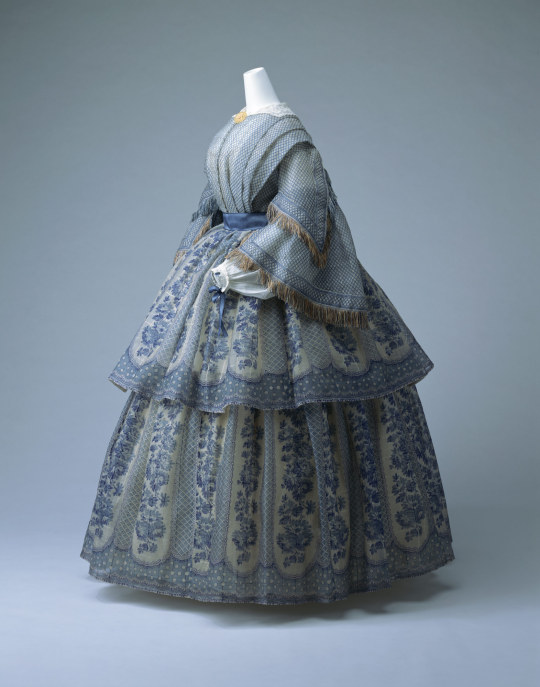
Day Dress
c.1855
England
This type of widely protruding skirt that appeared around the middle of the 19th century came to be known later under the name of the "crinoline style." As can be seen with this dress, large design motifs proved immensely effective on these voluminous skirts. The border pattern here is wood-block printed and repeats every 20.6 cm. Compared to small-scale designs, large patterns require a solid technique to avoid misalignment of the print colors. Considering that this mixed fabric of silk and wool is a material hard to print on, this dress with its bright and cheerful colors is a particularly fine example on how much cloth printing techniques had evolved.
The Kyoto Costume Institute
#day dress#fashion history#historical fashion#1850s#crinoline era#19th century#england#victorian#1855#blue#white#floral#flower print#kci
3K notes
·
View notes
Text

It’s finally time for another proper series- the Bells Hells in historical art styles!
First up is Saint Laudna with the tools of her martyrdom as stained glass. This is technically in the style of 19th century medieval revivalism.
I had a ton of fun studying stained glass techniques so I could replicate them while working on this. I specifically used a lot of (digital) sgraffito and back staining.
Fun fact- the “stain” in stained glass refers to silver stain, generally silver nitrate, which was used to build yellows on white glass, or greens on cobalt blue glass.
3K notes
·
View notes
Text
RE: how the tattoos would look when you get older and archeological evidence from an Egyptian perspective
Tattoos that were done at a young age in most of history would indeed distort and get blow out as you got older, to the point of being nearly unrecognizable if you got very old. Some photos of Egyptian women I've seen with traditional tattoos look like their faces are just smudged. However, those are VERY old women, often in their 80s or 90s. Traditional tattooing in Egypt is sometimes done as an adult, but written records indicate it was common for children as young as 5 to get tattoos. Copts traditionally tattooed our children at a young age too (some Copts I've talked to think this was to prevent them being kidnapped), but today I don't think doing them that young is as common for a lot of people, especially not for Copts in diaspora or in cities. These days a lot of us machines too, so the tattoo quality is better, but based on that and those old women likely being tattooed as children, I agree that the tattoo would distort over time. It also means that even by 30 or so, the tattoo design may still be recognizable, but there probably would be blow out making the tattoo appear blue-ish like you suggested
additionally in Egyptian archeology there's trouble establishing the commonality of tattoos for similar reasons you've described. One is we aren't sure of certain items were for tattooing, and the other is that tattoos on mummies are rarely visible with the naked eye. You have to scan them with a machine (I forget which one) to get the images, and only a few mummies have been scanned. One of then was on display for decades before being scanned and no one noticed the tattoos, or something like that, to give an idea of how it's slipped notice
Did the ancient Celts really paint themselves blue?
Part 2: Irish tattoos

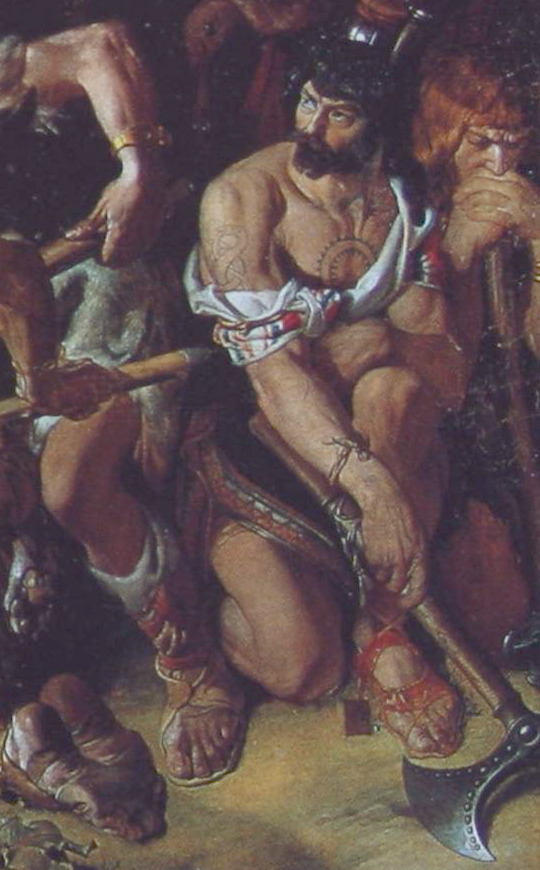

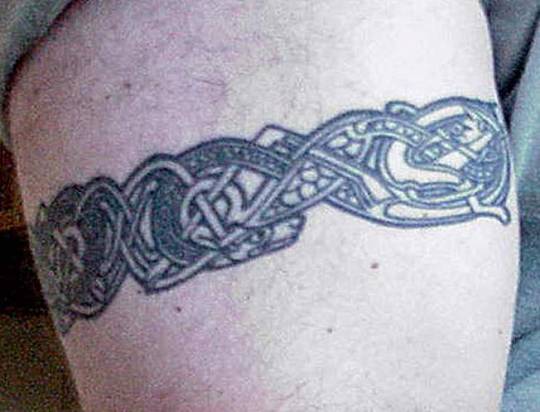
Clockwise from top left: Deirdre and Naoise from the Ulster Cycle by amylouioc, detail from The Marriage of Strongbow and Aoife by Daniel Maclise, a modern Celtic revival tattoo, Michael Flatley in a promotional image for the Irish step dance show 'Lord of the Dance'
This is my second post exploring the historical evidence for our modern belief that the ancient and medieval Insular Celts painted or tattooed themselves with blue pigment. In the first post, I discussed the fact that body paint seems to have been used by residents of Great Britain between approximately 50 BCE to 100 CE. In this post, I will examine the evidence for tattooing.
Once again, I am looking at sources pertaining to any ethnic group who lived in the British Isles, this time from the Roman Era to the early Middle Ages. The relevant text sources range from approximately 200 CE to 900 CE. I am including all British Isles cultures, because a) determining exactly which Insular culture various writers mean by terms like ‘Briton’, ‘Scot’, and ‘Pict’ is sometimes impossible and b) I don’t want to risk excluding any relevant evidence.
Continental Written Sources:
The earliest written source to mention tattoos in the British Isles is Herodian of Antioch’s History of the Roman Empire written circa 208 CE. In it, Herodian says of the Britons, "They tattoo their bodies with colored designs and drawings of all kinds of animals; for this reason they do not wear clothes, which would conceal the decorations on their bodies" (translation from MacQuarrie 1997). Herodian is probably reporting second-hand information given to him by soldiers who fought under Septimius Severus in Britain (MacQuarrie 1997) and shouldn't be considered a true primary source.
Also in the early 3rd century, Gaius Julius Solinus says in Collectanea Rerum Memorabilium 22.12, "regionem [Brittaniae] partim tenent barbari, quibus per artifices plagarum figuras iam inde a pueris variae animalium effigies incorporantur, inscriptisque visceribus hominis incremento pigmenti notae crescunt: nec quicquam mage patientiae loco nationes ferae ducunt, quam ut per memores cicatrices plurimum fuci artus bibant."
Translation: "The area [of Britain] is partly occupied by barbarians on whose bodies, from their childhood upwards, various forms of living creatures are represented by means of cunningly wrought marks: and when the flesh of the person has been deeply branded, then the marks of the pigment get larger as the man grows, and the barbaric nations regard it as the highest pitch of endurance to allow their limbs to drink in as much of the dye as possible through the scars which record this" (from MacQuarrie 1997).
This passage, like Herodian's, is clearly a description of tattooing, not body staining or painting. That said, I have no idea of tattoos actually work like this. I would think this would result in the adult having a faded, indistinct tattoo, but if anyone knows otherwise, please tell me.
The poet Claudian, writing in the early 5th c., is the first to specifically mention the Picts having tattoos (MacQuarrie 1997). In De Bello Gothico he says, "Venit & extremis legio praetenta Britannis,/ Quæ Scoto dat frena truci, ferroque notatas/ Perlegit exanimes Picto moriente figuras."
Translation: "The legion comes to make a trial of the most remote parts of Britain where it subdues the wild Scot and gazes on the iron-wrought figures on the face of the dying Pict" (from MacQuarrie 1997).
Last, and possibly least, of our Mediterranean sources is Isidore of Seville. In the early 7th c. he writes, "the Pictish race, their name derived from their body, which the efficient needle, with minute punctures, rubs in the juices squeezed from native plants so that it may bring these scars to its own fashion [. . .] The Scotti have their name from their own language by reason of [their] painted body, because they are marked by iron needles with dark coloring in the form of a marking of varying shapes." (translation from MacQuarrie 1997)
Isidore is the earliest writer to explicitly link the name 'Pict' to their 'painted' (Latin: pictus) i.e. tattooed bodies. Isidore probably borrowed information for his description from earlier writers like Claudian (MacQuarrie 1997).
In the 8th century, we have a source that definitely isn't Romans recycling old hearsay. In 786, a pair of papal legates visited the Anglo-Saxon kingdoms of Mercia and Northumbria (Story 1995). In their report to Pope Hadrian, the legates condemn pagans who have "superimposed most hideous cicatrices" (i.e gotten tattoos), likening the pagan practice to coloring oneself "with dirty spots". The location of the visit indicates that these are Anglo-Saxon tattoos rather than Celtic, but some scholars have suggested that the Anglo-Saxons might have adopted the practice from the Brittonic Celts (MacQuarrie 1997).
A gloss in the margin of the late 9th c. German manuscript Fulda Aa 2 defines Stingmata [sic] as "put pictures on the bodies as the Irish (Scotti) do." (translation from MacQuarrie 1997).
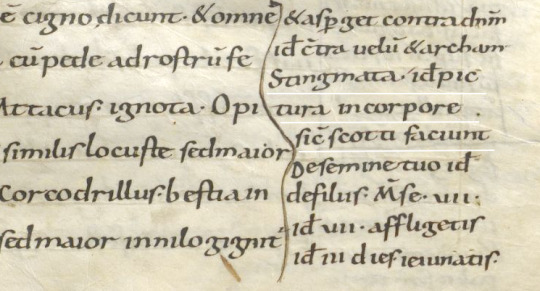
Fulda Aa 2 folio 43r The gloss is on the left underlined in white.
Irish Written Sources:
Irish texts that mention tattoos date to approximately 700-900 CE, although some of them have glosses that may be slightly later, and some of them cannot be precisely dated.
The first text source is a poem known in English as "The Caldron of Poesy," written in the early 8th c. (Breatnach 1981). The poem is purportedly the work of Amairgen, ollamh of the legendary Milesian kings. In the first stanza of the poem, he introduces himself saying, "I being white-kneed, blue-shanked, grey-bearded Amairgen." (translation from Breatnach 1981)
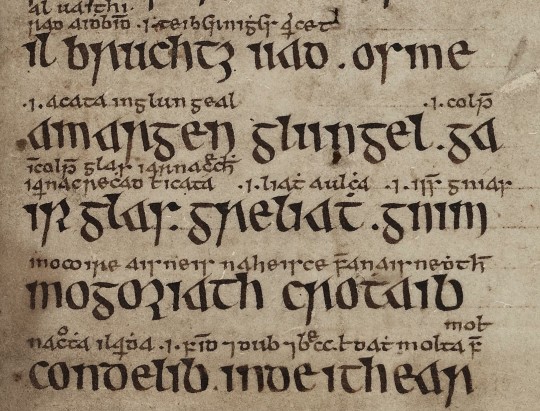
The text of the poem with interline glosses from Trinity College Dublin MS 1337/1
The word garrglas (blue-shanked) has a Middle Irish (c. 900-1200) gloss added by a later scribe, defining garrglas as: "a tattooed shank, or who has the blue tattooed shank" (Breatnach 1981).
Although Amairgen was a mythical figure, the position ollamh was not. An ollamh was the highest rank of poet in medieval Ireland, considered worthy of the same honor-price as a king (Carey 1997, Breatnach 1981). The fact that a man of such esteemed status introduces himself with the descriptor 'blue-shanked' suggests that tattoos were a respectable thing to have in early medieval Ireland.
The leg tattoos are also mentioned c. 900 CE in Cormac’s Glossary. It defines feirenn as "a thong which is about the calf of a man whence ‘a tattooed thong is tattooed about [the] calf’" (translation from MacQuarrie 1997)
The Irish legal text Uraicecht Becc, dated to the 9th or early 10th c., includes the word creccoire on a list of low-status occupations (Szacillo 2012, MacNeill 1924). A gloss defines it as: crechad glass ar na roscaib, a phrase which Szacillo interprets as meaning "making grey-blue sore (tattooing) on the eyes" (2012). This sounds rather strange, but another early Irish text clarifies it.
The Vita sancti Colmani abbatis de Land Elo written around the 8th-9th centuries (Szacillo 2012) contains the following episode:
On another time, St Colmán, looking upon his brother, who was the son of Beugne, saw that the lids of his eyes had been secretly painted with the hyacinth colour, as it was in the custom; and it was a great offence at St Colmán’s. He said to his brother: ‘May your eyes not see the light in your life (any more). And from that hour he was blind, seeing nothing until (his) death. (translation from Szacillo 2012).
The original Latin phrase describing what so offended St Colmán "palpebre oculorum illius latenter iacinto colore" does not contain the verb paint (pingo). It just says his eyelids were hyacinth (blue) colored. This passage together with the gloss from the Uraicecht Becc implies that there was a custom of tattooing people's eyelids blue in early medieval Ireland. A creccoire* was therefore a professional eyelid tattooer or a tattoo artist.
A possible third reference to tattooing the area around the eye is found in a list of Old Irish kennings. The kenning for the letter 'B' translates as 'Beauty of the eyebrow.' This kenning is glossed with the word crecad/creccad (McManus 1988). Crecad could be translated as cauterizing, branding, or tattooing (eDIL). McManus suggests "adornment (by tattooing) of the eyebrow" as a plausible interpretation of how crecad relates to the beauty of the eyebrow (1988). The precise date of this text is not known (McManus 1988), but Old Irish was used c. 600-900 CE, meaning this text is of a similar date to the other Irish references to tattoos.

Kenning of the letter 'b' with gloss from TCD MS 1337/1
There is a sharp contrast between the association of tattoos with a venerated figure in 'The Caldron of Poesy', and their association with low-status work and divine punishment in the Uraicecht Becc and the Vita. This indicates that there was a shift in the cultural attitude towards tattoos in Ireland during the 7th-9th centuries. The fact that a Christian saint considered getting tattoos a big enough offense to punish his own brother with blindness suggests that tattooing might have been a pagan practice which gradually got pushed out by the Catholic Church. This timeline is consistent with the 786 CE report of the papal legates condemning the pagan practice of tattooing in Great Britain (MacQuarrie 1997).
There are some mentions of tattooing in Lebor Gabála Érenn, but the information largely appears to be borrowed from Isidore of Seville (MacQuarrie 1997). The fact that the writers of LGE just regurgitated Isidore's meager descriptions of Pictish and Scottish (ie Irish) tattooing without adding any details, such as the designs used or which parts of the body were tattooed, makes me think that Insular tattooing practices had passed out of living memory by the time the book was written in the 11th century.
*There is some etymological controversy over this term. Some have suggested that the Old Irish word for eyelid-tattooer should actually be crechaire. more info Even if this hypothesis is correct, and the scribe who wrote the gloss on creccoire mistook it for crechaire, this doesn't contradict my argument. The scribe clearly believed that eyelid-tattooer belonged on a list of low-status occupations.
Discussion:
Like Julius Cesar in the last post, Herodian of Antioch c. 208 CE makes some dubious claims of Celtic barbarism, stating that the Britons were: "Strangers to clothing, the Britons wear ornaments of iron at their waists and throats; considering iron a symbol of wealth, they value this metal as other barbarians value gold" (translation from MacQuarrie 1997). If the Britons wore nothing but iron jewelry, then why did they have brass torcs and 5,000 objects that look like they're meant to attach to fabric, Herodian?
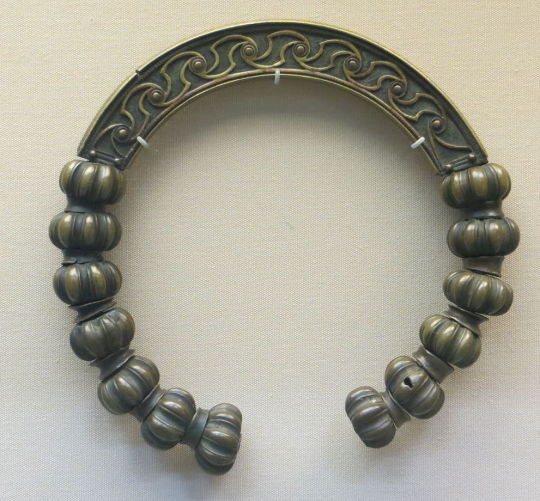

Brass torc from Lochar Moss, Scotland c. 50-200 CE. Romano-British trumpet brooch from Cumbria c. 75-175 CE. image from the Portable Antiquities Scheme.
Trumpet brooches are a Roman Era artifact invented in Britain, that were probably pinned to people's clothing. more info
Although Herodian and Solinus both make dubious claims, there are enough differences between them to indicate that they had 2 separate sources of information, and one was not just parroting the other. This combined with the fact that we have more-reliable sources from later centuries confirming the existence of tattoos in the British Isles makes it probable that there was at least a grain of truth to their claims of tattooing.
There is a common belief that the name Pict originated from the Latin pictus (painted), because the Picts had 'painted' or tattooed bodies. The Romans first used the name Pict to refer to inhabitants of Britain in 297 CE (Ware 2021), but the first mention of Pictish tattoos came in 402 CE (Carr 2005), and the first explicit statement that the name Pict was derived from the Picts' tattooed bodies came from Isidore of Seville c. 600 CE (MacQuarrie 1997). Unless someone can find an earlier source for this alleged etymology than Isidore, I am extremely skeptical of it.
Summary of the written evidence:
Some time between c. 79 CE (Pliny the Elder) and c. 208 CE (Herodian of Antioch) the practice of body art in Great Britain changed from staining or painting the skin to tattooing. Third century Celtic Briton tattoo designs depicted animals. Pictish tattoos are first mentioned in the 5th century.
The earliest mention of Irish tattoos comes from Isidore of Seville in the early 6th c., but since it seems to have been a pre-Christian practice, it likely started earlier. Irish tattoos of the 8-9th centuries were placed on the area around the eye and on the legs. They were a bluish color. The 8th c. Anglo-Saxons also had tattoos.
Tattooing in Ireland probably ended by the early 10th c., possibly because of Christian condemnation. Exactly when tattooing ended in Great Britain is unclear, but in the 12th c., William of Malmesbury describes it as a thing of the past (MacQuarrie 1997). None of these sources give much detail as to what the tattoos looked like.
The Archaeology of Insular Ink:
In spite of the fact that tattooing was a longer-lasting, more wide-spread practice in the British Isles than body painting, there is less archaeological evidence for it. This may be because the common tools used for tattooing, needles or blades for puncturing the skin, pigments to make the ink, and dishes to hold the ink, all had other common uses in the Middle Ages that could make an archaeologist overlook their use in tattooing. The same needle that was used to sew a tunic could also have been used to tattoo a leg (Carr 2005). A group of small, toothed bronze plates from a Romano-British site at Chalton, Hampshire might have been tattoo chisels (Carr 2005) or they might have been used to make stitching holes in leather (Cunliffe 1977).
Although the pigment used to make tattoos may be difficult to identify at archaeological sites, other lines of evidence might give us an idea of what it was. Although the written sources tell us that Irish tattoos were blue, the popular modern belief that woad was the source of the tattoo pigment is, in my opinion, extremely unlikely for a couple of reasons:
1) Blue pigment from woad doesn't seem to work as tattoo ink. The modern tattoo artists who have tried to use it have found that it burns out of the person's skin, leaving a scar with no trace of blue in it (Lambert 2004).
2) None of the historical sources actually mention tattooing with woad. Julius Cesar and Pliny the Elder mention something that might have been woad, but they were talking about body paint, not tattoos. (see previous post) Isidore of Seville claimed that the Picts were tattooing themselves with "juices squeezed from native plants", but even assuming that Isidore is a reliable source, you can't get blue from woad by just squeezing the juice out of it. In order to get blue out of woad, you have to first steep the leaves, then discard the leaves and add a base like ammonia to the vat (Carr 2005). The resulting dye vat is not something any knowledgeable person would describe as plant juice, so either Isidore had no idea what he was talking about, or he is talking about something other than blue pigment from woad.
In my opinion, the most likely pigment for early Irish and British tattoos is charcoal. Early tattoos found on mummies from Europe and Siberia all contain charcoal and no other colored pigment. These tattoos range in date from c. 3300 BCE (Ötzi the Iceman) to c. 300 CE (Oglakhty grave 4) (Samadelli et al 2015, Pankova 2013).
Despite the fact that charcoal is black, it tends to look blueish when used in tattoos (Pankova 2013). Even modern black ink tattoos that use carbon black pigment (which is effectively a purer form of charcoal) tend to look increasingly blue as they age.

A 17-year-old tattoo in carbon black ink photographed with a swatch of black Sharpie on white printer paper.
The fact that charcoal-based tattoo inks continue to be used today, more than 5,000 years after the first charcoal tattoo was given, shows that charcoal is an effective, relatively safe tattoo pigment, unlike woad. Additionally, charcoal can be easily produced with wood fires, meaning it would have been a readily available material for tattoo artists in the early medieval British Isles. We would need more direct evidence, like a tattooed body from the British Isles, to confirm its use though.
As of June 2024, there have been at least 279 bog bodies* found in the British Isles (Ó Floinn 1995, Turner 1995, Cowie, Picken, Wallace 2011, Giles 2020, BBC 2024), a handful of which have made it into modern museum collections. Unfortunately, tattoos have not been found on any of them. (We don't have a full scientific analysis for the 2023 Bellaghy find yet though.)
*This number includes some finds from fens. It does not include the Cladh Hallan composite mummies.
Tattoos in period art?
It has been suggested that the man fight a beast on Book of Kells f. 130r may be naked and covered in tattoos (MacQuarrie 1997). However, Dress in Ireland author Mairead Dunlevy interprets this illustration as a man wearing a jacket and trews (Dunlevy 1989). Looking at some of the other figures in the Book of Kells, I agree with Dunlevy. F. 97v shows the same long, fitted sleeves and round neckline. F. 292r has long, fitted leg coverings, presumably trews, and also long sleeves. The interlace and dot motifs on f. 130r's legs may be embroidery. Embroidered garments were a status symbol in early medieval Ireland (Dunlevy 1989).
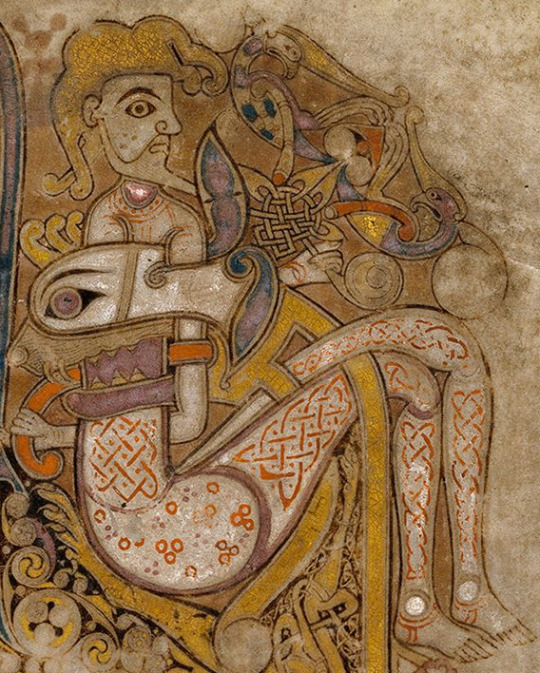
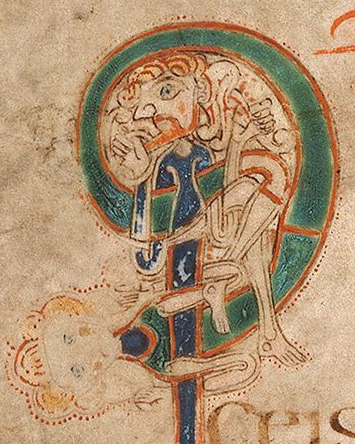
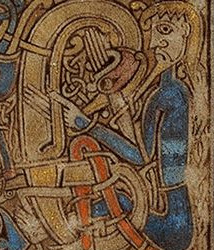
Left to right: Book of Kells folios 130r, 97v, 292r
A couple of sculptures in County Fermanagh might sport depictions of Irish tattoos. The first, known as the Bishop stone, is in the Killadeas cemetery. It features a carved head with 2 marks on the left side of the face, a double line beside the mouth and a single line below the eye. These lines may represent tattoos.
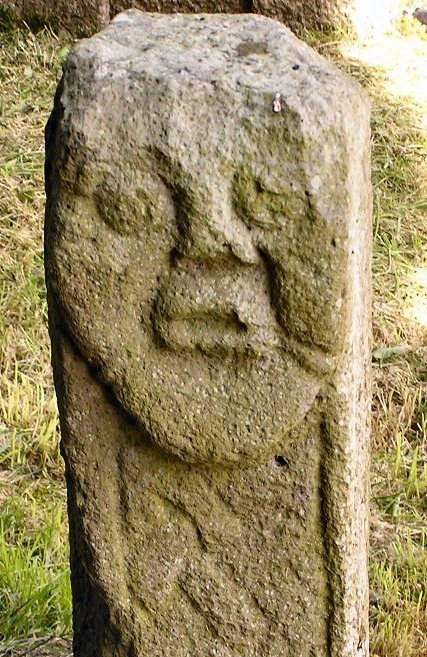

The second sculpture is the Janus figure on Boa Island. (So named because it has 2 faces; it's not Roman.) It has marks under the right eye and extending from the corner of the left eye that may be tattoos.
I cannot find a definitive date for the Bishop stone head, but it bears a strong resemblance to the nearby White Island church figures. The White Island figures are stylistically dated to the 9th-10th centuries and may come from a church that was destroyed by Vikings in 837 CE (Halpin and Newman 2006, Lowry-Corry 1959). The Janus figure is believed to be Iron Age or early medieval (Halpin and Newman 2006).
Conclusions:
Despite the fact that tattooing as a custom in the British Isles lasted for more than 500 years and was practiced by at least 3 different cultures, written sources remain our only solid evidence for it. With only a dozen sources, some of which probably copied each other, to cover this time span, there are huge gaps in our knowledge. The 4th century Picts may not have had the same tattoo designs, placements or reasons for getting tattooed as the 8th c. Irish or Anglo-Saxons. These sources only give us fragments of information on who got tattooed, where the tattoos were placed, what they looked like, how the tattoos were done, and why people got tattooed. Further complicating our limited information is the fact that most of the text sources come from foreigners and/or people who were prejudiced against tattooing, which calls their accuracy into question.
'The Cauldron of Posey' is one source that provides some detail while not showing prejudice against tattoos. The author of the poem was probably Christian, but the poem appears to have been written at a time when Pagan practices were still tolerated in Ireland. I have a complete translation of the poem along with a longer discussion of religious elements here.
Leave me a tip?
Bibliography:
BBC (2024). Bellaghy bog body: Human remains are 2,000 years old https://www.bbc.com/news/uk-northern-ireland-68092307
Breatnach, L. (1981). The Cauldron of Poesy. Ériu, 32(1981), 45-93. https://www.jstor.org/stable/30007454
Carey, J. (1997). The Three Things Required of a Poet. Ériu, 48(1997), 41-58. https://www.jstor.org/stable/30007956
Carr, Gillian. (2005). Woad, Tattooing and Identity in Later Iron Age and Early Roman Britain. Oxford Journal of Archaeology 24(3), 273–292. https://doi.org/10.1111/j.1468-0092.2005.00236.x
Cowie, T., Pickin, J. and Wallace, T. (2011). Bog bodies from Scotland: old finds, new records. Journal of Wetland Archaeology 10(1): 1–45.
Cunliffe, B. (1977) The Romano-British Village at Chalton, Hants. Proceedings of the Hampshire Field Club and Archaeological Society, 33(1977), 45-67.
Dunlevy, Mairead (1989). Dress in Ireland. B. T. Batsford LTD, London.
eDIL s.v. crechad https://dil.ie/12794
Giles, Melanie. (2020). Bog Bodies Face to face with the past. Manchester University Press, Manchester. https://library.oapen.org/viewer/web/viewer.html?file=/bitstream/handle/20.500.12657/46717/9781526150196_fullhl.pdf?sequence=1&isAllowed=y
Halpin, A., Newman, C. (2006). Ireland: An Oxford Archaeological Guide to Sites from Earliest Times to AD 1600. Oxford University Press, Oxford. https://archive.org/details/irelandoxfordarc0000halp/page/n3/mode/2up
Hoecherl, M. (2016). Controlling Colours: Function and Meaning of Colour in the British Iron Age. Archaeopress Publishing LTD, Oxford. https://www.google.com/books/edition/Controlling_Colours/WRteEAAAQBAJ?hl=en&gbpv=0
Lambert, S. K. (2004). The Problem of the Woad. Dunsgathan.net. https://dunsgathan.net/essays/woad.htm
Lowry-Corry, D. (1959). A Newly Discovered Statue at the Church on White Island, County Fermanagh. Ulster Journal of Archaeology, 22(1959), 59-66. https://www.jstor.org/stable/20567530
MacQuarrie, Charles. (1997). Insular Celtic tattooing: History, myth and metaphor. Etudes Celtiques, 33, 159-189. https://doi.org/10.3406/ecelt.1997.2117
McManus, D. (1988). Irish Letter-Names and Their Kennings. Ériu, 39(1988), 127-168. https://www.jstor.org/stable/30024135
Ó Floinn, R. (1995). Recent research into Irish bog bodies. In R. C. Turner and R. G. Scaife (eds) Bog Bodies: New Discoveries and New Perspectives (p. 137–45). British Museum Press, London. ISBN: 9780714123059
Pankova, S. (2013). One More Culture with Ancient Tattoo Tradition in Southern Siberia: Tattoos on a Mummy from the Oglakhty Burial Ground, 3rd-4th century AD. Zurich Studies in Archaeology, 9(2013), 75-86.
Samadelli, M., Melisc, M., Miccolic, M., Vigld, E.E., Zinka, A.R. (2015). Complete mapping of the tattoos of the 5300-year-old Tyrolean Iceman. Journal of Cultural Heritage, 16(2015), 753–758.
Story, Joanna (1995). Charlemagne and Northumbria : the in
fluence of Francia on Northumbrian politics in the later eighth and early ninth centuries. [Doctoral Thesis]. Durham University. http://etheses.dur.ac.uk/1460/
Szacillo, J. (2012). Irish hagiography and its dating: a study of the O'Donohue group of Irish saints' lives. [Doctoral Thesis]. Queen's University Belfast.
Turner, R.C. (1995). Resent Research into British Bog Bodies. In R. C. Turner and R. G. Scaife (eds) Bog Bodies: New Discoveries and New Perspectives (p. 221–34). British Museum Press, London. ISBN: 9780714123059
Ware, C. (2021). A Literary Commentary on Panegyrici Latini VI(7) An Oration Delivered Before the Emperor Constantine in Trier, ca. AD 310. Cambridge University Press, Cambridge. https://www.google.com/books/edition/A_Literary_Commentary_on_Panegyrici_Lati/oEwMEAAAQBAJ?hl=en&gbpv=0
#Fashion#Traditional Egyptian tattoos often used smoke black as pigment with additives to make it come out looking blueish or greenish#According to Lane anyway#Which isn't directly relevant here as there's no evidence from what you outlined that Celts would know how to do that#And it is at least a 19th century technique so. Throughly modern. And from a different continent#But it might be something to keep in mind to see if they /did/ independently come up with a similar technique#Many Copts do still get tattoos tbc#I just don't think 5 is a common age for it
102 notes
·
View notes
Text

Okay I know this horse has been beaten to death but I've been chewing on this for a while and I still havent seen anyone mention anything--
Im running with the assumption the picture of Narinder on the Lamb's desk is a photograph due to the rendering being completely different than their drawings.
Judging by the phonograph, we can assume the more advanced technology in this world is on par with the latter half of the 19th century (or at least vaguely victorian era inspired; 1820-1914). During this time photography was growing in popularity. Many methods evolved to refine the technique but a popular format for capturing portraits specifically was a daguerreotype.
And, well, here's the thing about early photography

do what you will with this knowledge, but theres good reason why victorian era portraits always looked so stoic
Moreover, there's a good chance Narinder had to hold this pose for at least 30 seconds, and at most 30 minutes

#cult of the lamb#cotl#narinder#narilamb#cotl narinder#i dont want to get too into the weeds on the history of photography#because I dont want to assume the tech from this universe is a one to one parallel ofc#but I studied it when learning animation history and THERES A REASON WHY FILM SPRUNG SO LATE FROM PHOTOGRAPHY
431 notes
·
View notes
Text
Chaos Magick
Chaos Magick is a modern form of occultism that defies traditional structures and dogmas, embracing a pragmatic, results-oriented approach to magical practice. Unlike conventional magical systems that adhere to specific rituals, symbols, and deities, Chaos Magick emphasizes flexibility, personal belief, and the use of any technique or symbolism that achieves the desired outcome. Originating in the late 20th century, Chaos Magick has become a significant and influential movement within the broader landscape of contemporary occultism, attracting practitioners who value creativity, experimentation, and personal empowerment. This essay explores the history, principles, practices, and significance of Chaos Magick.
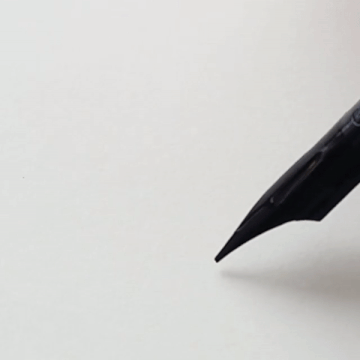
History of Chaos Magick
Chaos Magick emerged in the late 1970s and early 1980s as a response to the rigid structures of traditional ceremonial magick and the occult revival movements of the 19th and 20th centuries. The origins of Chaos Magick can be traced to the writings of occultists such as Peter J. Carroll and Ray Sherwin, who were instrumental in developing and popularizing this new approach to magic.
The Influence of Austin Osman Spare:
A significant precursor to Chaos Magick was the work of artist and occultist Austin Osman Spare (1886-1956). Spare's ideas about the subconscious mind, sigils, and the power of belief were highly influential on later Chaos Magicians. He emphasized the use of personal symbols and the manipulation of belief as tools for magical success, laying the groundwork for many of the ideas central to Chaos Magick.
The Birth of the Movement:
In the late 1970s, Peter J. Carroll and Ray Sherwin co-founded the Illuminates of Thanateros (IOT), a magical order dedicated to the practice and development of Chaos Magick. Carroll’s seminal works, "Liber Null" (1978) and "Psychonaut" (1982), became foundational texts for Chaos Magicians. These books outlined the core principles of Chaos Magick, including the emphasis on belief as a tool, the use of sigils, and the concept of "paradigm shifting," where practitioners adopt different belief systems as needed.
Spread and Evolution:
Throughout the 1980s and 1990s, Chaos Magick grew in popularity, particularly in the United Kingdom and the United States. The movement attracted individuals interested in a more personalized and experimental approach to magic, free from the dogmatic constraints of traditional systems. As Chaos Magick evolved, it incorporated influences from psychology, science fiction, pop culture, and postmodern philosophy, reflecting its eclectic and adaptive nature.
Principles of Chaos Magick
Chaos Magick is characterized by several key principles that distinguish it from other forms of magical practice. These principles emphasize flexibility, pragmatism, and the central role of belief in achieving magical outcomes.
Belief as a Tool:
One of the core tenets of Chaos Magick is the idea that belief itself is a powerful tool in magic. Unlike traditional magical systems that require adherence to specific beliefs or deities, Chaos Magick posits that the act of believing—regardless of what is believed—is what makes magic effective. Practitioners are encouraged to adopt and discard beliefs as needed to achieve their desired results, treating belief as a flexible and dynamic tool rather than a fixed truth.
Paradigm Shifting:
Closely related to the use of belief as a tool is the concept of "paradigm shifting." In Chaos Magick, a paradigm is a framework of beliefs, symbols, and practices that a magician temporarily adopts to work a particular spell or ritual. A Chaos Magician might shift between different paradigms—such as using Kabbalistic symbols in one ritual and invoking Lovecraftian deities in another—depending on what they find most effective for their goals. This fluid approach allows practitioners to draw from a wide range of magical and cultural traditions.
Pragmatism and Results-Oriented Practice:
Chaos Magick is inherently pragmatic, focusing on what works rather than adhering to tradition or doctrine. The effectiveness of a magical practice is judged solely by the results it produces. This results-oriented approach encourages experimentation and the development of new techniques, as well as the modification or abandonment of practices that do not yield desired outcomes.
Use of Sigils:
Sigilization, a technique popularized by Austin Osman Spare, is a central practice in Chaos Magick. A sigil is a symbol created by condensing a specific intention or desire into a visual form. The practitioner then uses various methods to "charge" the sigil with energy and launch it into the subconscious mind, where it works to manifest the desired outcome. Sigils are valued for their simplicity and adaptability, making them a popular tool among Chaos Magicians.
The Gnostic State:
Achieving a state of altered consciousness, often referred to as the "Gnostic State" or "gnosis," is a key component of Chaos Magick rituals. This state of mind, in which the practitioner is highly focused and free from distractions, is believed to be crucial for the successful performance of magic. Various methods, such as meditation, chanting, visualization, or sensory deprivation, are used to induce gnosis.
Practices of Chaos Magick
Chaos Magick is known for its eclectic and innovative practices, which can vary widely from one practitioner to another. The following are some of the most common practices associated with Chaos Magick:
Sigil Magic:
As mentioned, sigil magic is a cornerstone of Chaos Magick. The process typically involves creating a sigil by writing out a statement of intent, removing duplicate letters, and arranging the remaining letters into an abstract symbol. The practitioner then enters a Gnostic State, charges the sigil with intent, and either destroys or forgets the sigil to allow it to work subconsciously.
Magical Experimentation:
Chaos Magicians often experiment with a variety of techniques, drawing from different magical traditions, religions, and even pop culture. This might include invoking gods from different pantheons, working with fictional characters as if they were real entities, or incorporating elements of modern technology into rituals. The emphasis is always on what is effective for the individual practitioner.
Deconstructing and Reconstructing Beliefs:
Chaos Magicians regularly engage in the practice of deconstructing and reconstructing their beliefs. By deliberately adopting different belief systems, even those they do not inherently believe in, they explore the effects of belief on reality. This practice often leads to a deeper understanding of the fluid nature of reality and the power of the mind in shaping experience.
Use of Pop Culture and Modern Symbols:
One of the more unique aspects of Chaos Magick is its embrace of contemporary symbols and icons from pop culture. Practitioners might use characters from movies, comic books, or video games as symbols in their rituals, treating these figures as modern-day deities or archetypes. This reflects Chaos Magick's adaptability and its focus on personal relevance over tradition.
Psychological Techniques:
Many Chaos Magicians incorporate psychological techniques into their practice, drawing from fields such as cognitive psychology, NLP (Neuro-Linguistic Programming), and hypnosis. These techniques are used to alter consciousness, influence perception, and reinforce the practitioner’s intent. The integration of psychological methods underscores Chaos Magick's pragmatic and results-driven approach.
Significance and Influence of Chaos Magick
Chaos Magick has had a profound impact on modern occultism, influencing both magical practice and the broader cultural understanding of magic. Its emphasis on flexibility, innovation, and personal empowerment has resonated with a new generation of practitioners who seek a more individualized and adaptive approach to magic.
Democratization of Magic:
One of the most significant contributions of Chaos Magick is the democratization of magical practice. By rejecting rigid hierarchies, dogmas, and the need for formal initiation, Chaos Magick has made occult practices more accessible to a wider audience. Anyone can become a Chaos Magician, regardless of background or experience, as long as they are willing to experiment and learn.
Cultural Impact:
Chaos Magick has also influenced popular culture, particularly in areas related to the occult, science fiction, and the countercultural movements of the late 20th and early 21st centuries. Concepts from Chaos Magick, such as paradigm shifting and the use of pop culture symbols, have found their way into literature, movies, and art, reflecting the movement's broad cultural reach.
Challenges to Traditional Magic:
Chaos Magick challenges the conventional understanding of magic by questioning the necessity of belief in any particular system or deity. This has led to debates within the occult community about the nature of magic, the role of belief, and the effectiveness of traditional practices. Chaos Magick's focus on results over tradition has encouraged many practitioners to rethink their approach to magic.
Influence on Postmodern Thought:
Chaos Magick is often associated with postmodernism, particularly its skepticism of grand narratives and its emphasis on individual experience. The movement’s fluid approach to reality, belief, and identity aligns with postmodern ideas about the constructed nature of reality and the multiplicity of truths. This has made Chaos Magick particularly appealing to those who resonate with postmodern philosophy.
Conclusion
Chaos Magick represents a radical departure from traditional magical systems, offering a flexible, pragmatic, and highly individualized approach to occult practice. By emphasizing the power of belief, the importance of personal experience, and the value of experimentation, Chaos Magick has redefined what it means to practice magic in the modern world. Its influence extends beyond the occult community, challenging cultural and philosophical assumptions about reality, belief, and the nature of power. As a living, evolving tradition, Chaos Magick continues to inspire and empower those who seek to explore the mysteries of existence on their own terms.

#mysticism#occultism#metaphysics#mystic#magick#chaos magick#sigil magick#witchcraft#witchblr#witch#wicca#grimoire#chatgpt
211 notes
·
View notes
Text
Word List: Fashion History
to try to include in your poem/story (pt. 1/3)
Adinkra - a flat, cotton textile that is stamped with symbols which create the meaning of the garment; produced by the Asante peoples in Ghana
Agal - a rope made from animal hair which wraps around a keffiya (square cloth) on the head and is worn typically by Bedouin men
Akwete - a decorative cloth with complex weave designs, creating intricate geometric patterns, made with many vibrant colors; it is usually made into wrappers for women to wear and it is made by the Igbo women of Nigeria
Aniline Dyes - synthetic, chemical dyes for garments first invented in the 19th century
Anorak - a jacket that typically has a hood, but not always, which was originally worn by the indigenous peoples of the Arctic designed to keep them warm and protected from harsh weather
Back Apron (Negbe) - an oval-shaped decorative pad worn by Mangbetu women over the buttocks in Central Africa
Backstrap Loom - a lightweight, mobile loom made of wood and a strap that is wrapped around the back; it only needed to be attached to a tree or a post for stability and to provide tension
Banyan - a loose-fitted informal robe or gown typically worn by men in the late 17th to the early 19th centuries
Barbette - a piece of linen which passes under the chin and is pinned at the sides, usually worn in conjunction with additional head coverings during the Middle Ages
Bark Cloth - fabric made out of bark from trees
Beadnet Dress - a decorative sheath dress made of beads worn in ancient Egypt
Bloomers - a bifurcated garment that were worn under dresses in the 19th century; they soon became a symbol of women’s rights because early activist Amelia Bloomer wore drawers long enough to stick out from under her dress
Bogolanfini - (bogolan- meaning cloth; fini- meaning mud) a cotton cloth made from strips of woven fabric, which are decorated with symbolic patterns using the mud-resist technique, sewn together at the selvage to create a fabric that is utilized during the main four stages of a West African Bamana woman’s life: puberty, marriage, motherhood, and death
Bombast/Bombasted - the padding used to structure clothing and create fashionable silhouettes in the 16th and 17th centuries
Boubou - an African robe made of one large rectangle of fabric with an opening in the center for the neck; when worn it drapes down over the shoulders and billows at the sleeves
Buff Coat - a leather version of the doublet that was often, but not exclusively, worn by people in the military in the 17th century
Bum Roll - a roll of padding tied around the hip line to hold a woman’s skirt out from the body in the late 16th and early 17th centuries
Burqa - an outer garment worn by Muslim women that covers the entire body, often with a cutout or mesh at the eyes
Busk - a flat length stay piece that was inserted into the front of a corset to keep it stiff from the 16th century to the early 20th century
Bustle - a pad or frame worn under a skirt puffing it out behind
Cage Crinoline - a hooped cage worn under petticoats in the 19th century to stiffen and extend the skirt
Caraco - 18th century women’s jacket, fitted around the torso and flared out after the waist
Carrick Coat - an overcoat with three to five cape collars popular in the 19th century and mostly worn for riding and travel–sometimes called a Garrick or coachman’s coat
Chantilly Lace - a kind of bobbin lace popularized in 18th century France; it is identifiable by its fine ground, outlined pattern, and abundant detail, and was generally made from black silk thread
Chaperon - a turban-like headdress worn during the Middle Ages in Western Europe
Chemisette - a piece of fabric worn under bodices in the 19th century to fill in low necklines for modesty and decoration
Chiton - an ancient Greek garment created from a single piece of cloth wrapped around the body and held together by pins at the shoulders
Chlamys - a rectangular cloak fastened at the neck or shoulder that wraps around the body like a cape
Chopines - high platform shoes worn mostly in Venice in the 16th & 17th centuries
Clavus/Clavi - decorative vertical stripes that ran over the shoulder on the front and back of a Late Roman or Byzantine tunic
Clocks/Clocking - decorative and strengthening embroidery on stockings in Europe and America during the 16th-19th centuries
Cochineal Dyes - come from the Cochineal beetle that is native to the Americas and is most commonly found on prickly pear cacti; when dried and crushed, it creates its famous red pigment that is used to dye textiles
Codpiece - originally created as the join between the two hoses at the groin, the codpiece eventually became an ornate piece of male dress in the 16th century
Cuirass Bodice - a form-fitting, long-waisted, boned bodice worn in the 1870s and 1880s–almost gives the appearance of armor as the name suggests
Dagging - an extremely popular decorative edging technique created by cutting that reached its height during the Middle Ages and Renaissance
Dalmatic Tunic - a t-shaped tunic with very wide sleeves; worn by both men and women during the Byzantine empire
Dashiki - a loose-fitting pullover tunic traditionally worn in West African cultures that was adopted by African diasporic communities as a symbol of African heritage in the 1960s and then more widely worn as a popular item of “ethnic” fashion
Dentalium Cape - or dentalium dress is a garment worn by Native American women that is made from the stringing together of dentalium shells in a circular pattern around the neck and across the chest and shoulders
Doublet - an often snug-fitting jacket that is shaped and fitted to a man’s body–worn mostly in the 15th to 17th centuries
Échelle - a decorative ladder of bows descending down the stomacher of a dress; worn during the late 17th and 18th centuries; sometimes spelled eschelle
If any of these words make their way into your next poem/story, please tag me, or leave a link in the replies. I would love to read them!
More: Fashion History ⚜ Word Lists
#word list#fashion history#writeblr#dark academia#spilled ink#writers on tumblr#writing prompt#terminology#poetry#poets on tumblr#literature#light academia#studyblr#linguistics#lit#words#fashion#culture#worldbuilding#creative writing#writing reference#fiction#writing tips#writing advice#writing resources
264 notes
·
View notes
Text
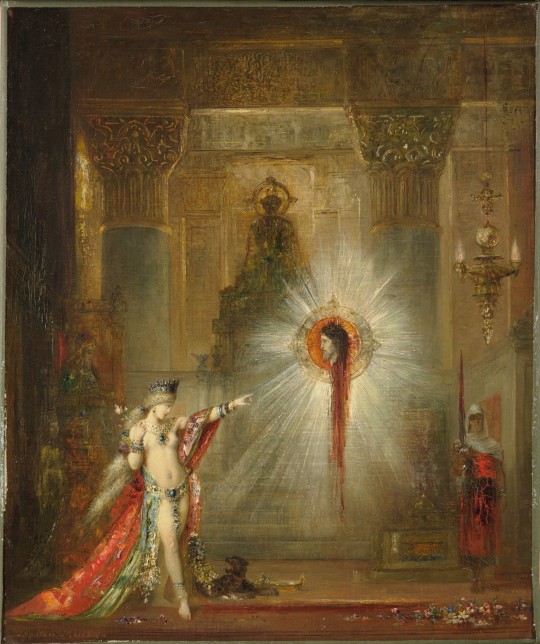
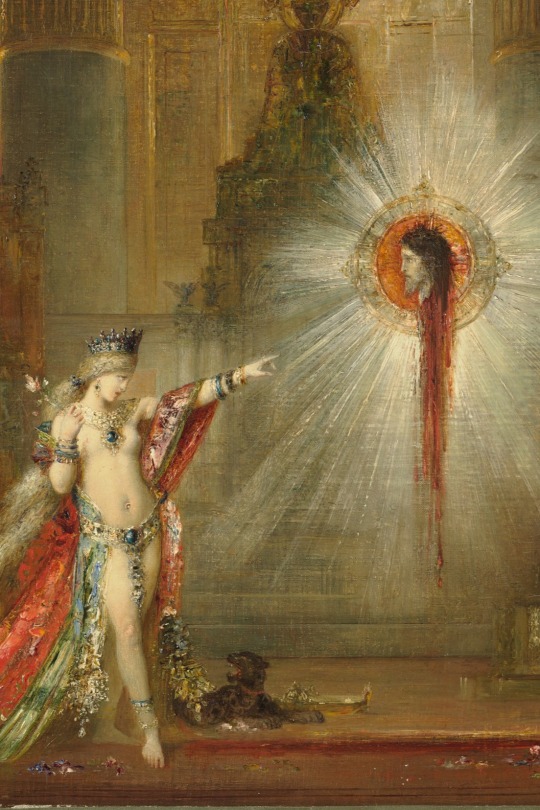
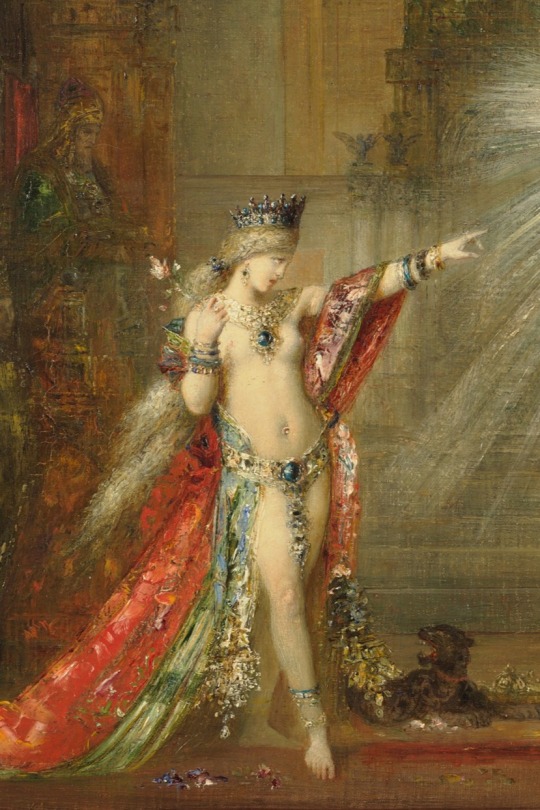
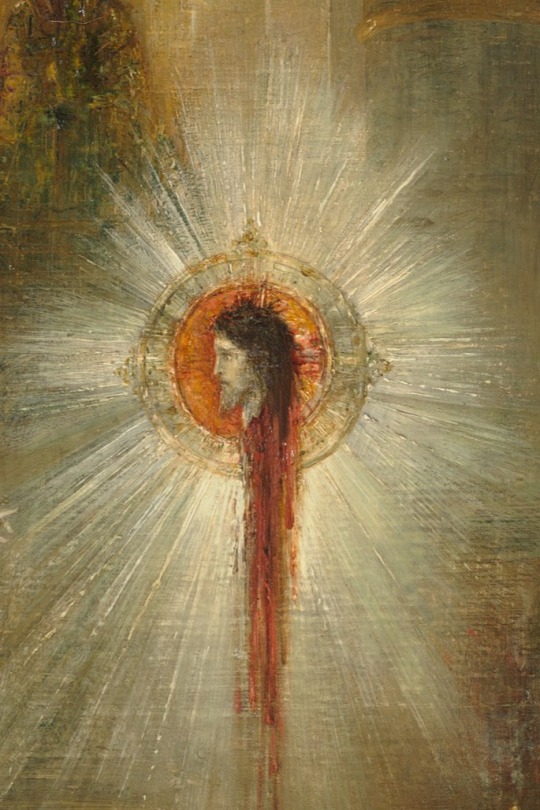
THE APPARITION /c. 1876/ by GUSTAVE MOREAU
The painting is a representation of the biblical figure Salome, she danced before King Herod and, as a reward, asked for the beheading of John the Baptist. In "The Apparition," Salome assumes a mystic and sensual posture with the ghostly image of John the Baptist's head suddenly appearing in the foreground.
Symbolic elements, such as the glowing head of John the Baptist and Salome's reaching bare arm, speak volumes about complicated ideas on lust, death, and the interplay between beauty and horror. This layering of meaning is characteristic of symbolism, where objects go deeper than the surface.
Moreau used a series of creative techniques in the painting, such as highlighting, grattage (scraping the surface of the paint), and even incisions to the surface of the paint, to obtain texture and depth. These techniques add to the ethereal quality and really contribute to the dream-like atmosphere that Moreau has attempted to invoke in this painting.
Created in a period when interest in the Orient and in exoticism was at its peak. In fact, this painting represents late 19th-century European fascination with Eastern themes and aesthetics. The attention to detail and the use of jewel-like colors create a captivating composition. The long, sinuous lines create a sense of fluency and movement throughout the composition.
206 notes
·
View notes
Text
A short Takemiya Keiko interview from 1998
My "All Things Takemiya" detective friend, Platypus, provided me with a two-page Takemiya Keiko interview scanned by @97tears from the now discontinued Hato yo! (鳩よ! - Oh, Pigeons!) magazine. It was a literary magazine published between 1983 and 2002—a publication you probably wouldn't look at if you were searching up on Takemiya, ig.
You can see the Japanese original taken from the 1998 April issue of the magazine, and my (poor) translation of it under the cut.
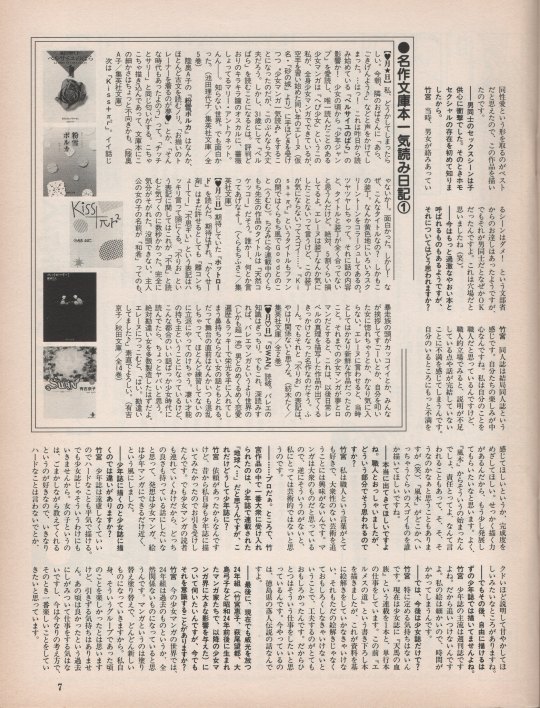

Takemiya Keiko Interview from issue #4 of Hato yo (1998)
An interview with a master mangaka herself!
I’ve always wanted to meet them! 1 – Takemiya Keiko
“I wanted to draw real love”
Takemiya Keiko. Born in Tokushima in 1950. Debuted with “Ringo no Tsumi” in 1968. Won the 25th Shogakukan Manga Award with “Kaze to Ki no Uta” and “Terra e.” Representative works include “Pharaoh no Haka” among others. “Tenma no Ketsuzoku” is currently being serialized in Asuka Magazine.
I read “Kaze to Ki no Uta” during elementary school. It has left a very deep impression on me. I remember that when Ms. Takemiya is mentioned. It was like I was looking at something I was not supposed to look, and I still remember the thrill I felt. Takemiya: Oh, is that so? (laughs)
Thank you so much for being with me today. Takemiya: And thank you for having me.
Shall we start with what prompted you to become a shoujo manga artist? Takemiya: Fundamentally, I was not suited for shoujo manga. I debuted in COM, and my dream was to draw manga that was neither shounen nor shoujo. But alas, the magazine in which I could draw my ideal manga was no more. My style didn’t have much “power” in it, so I inevitably had to choose a shoujo manga magazine. I think my art style was really uncommon at the time. But it was what it was, and I thought to myself, maybe capitalizing on that was the path I should take.
Your works have an extraordinary depth as far shoujo manga goes... They have a unique art style... Takemiya: It hasn’t always been like that. My shoujo manga technique was the fruit of what I have studied. It was not a result of my personal taste, nor my innate skills. Girls like that feathery, light touch. They like fine lines. But I didn’t have any of those. So, I figured drawing things girls would like a lot was my only choice. For instance, when I thought how they must like Europe at the end of the 19th century, I went on a trip as a result. I saw the real thing at its source, and did research on it.
Then was Kaze to Ki no Uta born because you thought girls would like it? Takemiya: That might have played into my choice of the time period the story’s set in. However, romance stories between a boy and a girl was the norm in shoujo manga at the time. You could only draw “And they lived happily ever after...” stories. And that happiness was only on the emotional level. It was normal to exclude all physical contact. But that is simply “affection.” I wanted to draw “real love.” I admit it was a little too sensational, but I thought doing it through same-sex love was the best way to go about it. That’s how I drew Kaze to Ki no Uta.
The sex scenes between men were quite a shock for me as a little child. That’s how I learned homosexuality existed. Takemiya: At the time, there was an official notice published by the Ministry of Education that stipulated that “You shall not draw a boy and a girl getting intimate!” However, if it was two boys, things were somehow fine... I thought I’d found a loophole! (laughs)
These days, there are more extreme books labeled as “yaoi.” What do you think about them? Takemiya: At the end of the day, doujinshi are doujinshi. They focus on personal enjoyment of a group. I consider myself a “craftsman,” and if I look at it from a craftsman's standpoint, I am not wholly satisfied with how they leave many things unexplained, or how they have no conclusion. At their level, I’d liked if those artists too felt more dissatisfied... If they aimed to be more conclusive. They have the talent to draw, so I’d love them to polish those skills. I’m sometimes told that it all started with “Kazeki,” and that I must take responsibility. And every time, I think to myself, “Oh... Re-really? Dit it?” (laughs) I wish someone drew something so awesome that it would blow Kazeki out of the water...
I’d love that too! You called yourself a “craftsman,” but what exactly makes you think so? Takemiya: I really love the word “craftsman.” I’m not interested in trying to reach an ideal of art that would not resonate with the public. I believe manga is something aimed at the general public. Otherwise, I would not consider it to have artistic value.
Spoken like a real pro... Which brings me to Terra e... I think that’s the most widely-accepted manga of yours by the general public, and it was published in a shounen magazine. Why is it the outlier to be published in a shounen magazine? Takemiya: I received an offer for it, but the truth is, I had always wanted to draw for a shounen magazine. That’s why accepted. But I needed to draw in the shoujo manga audience too, so I wanted the story to offer the best for both demographics. So I tried to have the concept to be that of shoujo manga, and the style to be that of shounen manga as much as possible.
Is it different to draw for a shounen manga magazine, and a shoujo manga magazine? Takemiya: You don’t have to hold back in shounen magazines. It fine to draw more hardcore stuff. But in shoujo magazines, that’s out of the question. There’s a trend that dictate that you should explain things in long-winded ways and spoil the reader, because girls like it when you reveal things to them through subterfuge, so don’t hit them directly with hard stuff.
But after that, you’ve never drawn for shounen magazines which allowed you to draw as you wished. Takemiya: Shounen magazines are mostly weekly. I cannot keep up with that. My art has fine details, so it takes me a lot of time to draw.
Then will you be solely drawing for shoujo magazines in the future? Takemiya: I can’t really say that I will. I’m currently working for a shoujo magazine with “Tenma no Ketsuzoku”, and with volume releases. I recently released an illustration book titled “Hermès no Michi.” I needed to base myself on documents and explain them in drawings. And they couldn’t be any kind of drawing, they needed to be interesting. Trying to come up with ways to do that was a very fun experience. So for starters, I’d like to undertake a work like that again. That kind of work I’m working on right now is a story about the fugitives of the Heike Clan in Tokushima.*
*T/N: She is referring to “Heian Joururi Monogatari.”
To finish our interview off, I’d like ask a question about the Year 24 Group (shoujo manga artists born around the 24th year of the Shouwa Era like Takemiya Keiko, Hagio Moto, and Ooshima Yumiko, who have influenced the shoujo manga world in the following years) which is still very prominent: Are you still conscious of it? Takemiya: Year 24 is a thing of the past in the modern manga scene. I think it’s irrelevant now. Manga is evolving, becoming something else after being painted over continuously. I had fun when I was part of that group, but I don’t feel like dragging it out. I don’t want to cling to nice memories of the past as I work, and want to focus on how I currently think and feel. I want to do what I think is most fun at the moment.
#takemiya keiko#keiko takemiya#竹宮 惠子#24年組#year 24 group#interview#hato yo!#鳩よ!#shoujo manga history#manga history#kaze to ki no uta#風と木の詩#takemiya keiko interview#yaoi
125 notes
·
View notes